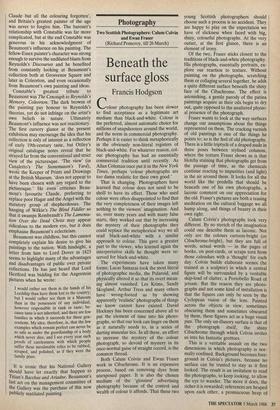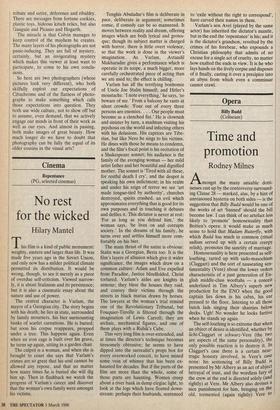Photography Two Scottish Photographers: Calum Colvin and Ewan Fraser (Richard
Pomeroy, till 26 March) Beneath the
surface gloss
Francis Hodgson
Colour photography has been slower to find acceptance as a legitimate art medium than black-and-white. Colour is the preferred, almost automatic choice for millions of snapshooters around the world, and the norm in commercial photography. Perhaps it is easier to think metaphorically in the obviously non-literal registers of black-and-white. For whatever reason, col- our photography has had an essentially commercial tradition until recently. As Allan Coleman once put it in the New York Times, perhaps 'colour photographs are too damn realistic for their own good.'
That is changing. Photographers have learned that colour does not need to be shrill to have its effect. Those who used colour were often disappointed to find that the very completeness of their images left nothing to the viewers' imagination. And so, over many years and with many false starts, they worked out that by increasing the mystery of their photographs they could replace the metaphorical way we all read black-and-white with a similar approach to colour. This gave a greater part to the viewer, who learned again the interpretative skills he thought were re- served for black-and-white.
The experiments have taken many forms:. Lucas Samaras took the most literal of photographic media, the Polaroid, and physically altered it so that its overt mean- ing almost vanished. Les Krims, Sandy Skoglund, Arthur Tress and many others have wrong-footed us by showing apparently 'realistic' photographs of things we know cannot have existed. David Hockney has been concerned above all to put the element of time into his photo- graphs, so that our look can linger on them as it naturally needs to, in a series of darting muscular tics. In all these, an effort to increase the mystery of the colour photograph, so devoid of mystery in its once-normal guise of straight record, is the common thread.
Both Calum Colvin and Ewan Fraser work in Cibachrome. It is an expensive process, based on removing dyes from unexposed paper. It is also the chosen medium of the 'glossiest' advertising photography because of the control and wealth of colour it affords. That these two young Scottish photographers should choose such a process is no accident. They are happy to play on the expectation we have of slickness when faced with big, shiny, colourful photographs. At the very outset, at the first glance, there is an element of irony.
Of the two, Fraser sticks closest to the traditions of black-and-white photography. His photographs, essentially portraits, ex- plore our reaction to texture. Without painting on the photographs, scratching them or collaging several together, he adds a quite different surface beneath the shiny face of the Cibachrome. The effect is astonishing, a gentle parody of the patina paintings acquire as their oils begin to dry out, quite opposed to the unaltered physic- al presence of the photograph.
Fraser wants to look at the way surfaces change our assumptions about the things represented on them. The cracking varnish of old paintings is one of the things he points to; so is the feel of old photographs. There is a little triptych of a draped nude in three poses between stylised columns, where the texture Fraser shows us is that blotchy staining that photographs get from the passage of time, as the chemicals continue reacting to impurities (and light) in the air around them. It looks for all the world like the predella that should be beneath one of his own photographs, a laconic comment on our appreciation for the old. Fraser's pictures are both a teasing meditation on the cultural baggage we all hump along, and things of beauty in their own right.
Calum Colvin's photographs look very different. By no stretch of the imagination could one describe them as laconic. Not only are the colours cartoon-bright (or Cibachrome-bright), but they are full of words, actual words — in the pages of books, on post-cards, or scraps torn from those calendars with a. 'thought' for each day. Colvin builds elaborate scenes (he trained as a sculptor) in which a central figure will be surrounded by a veritable skip-load of clutter, a Portobello Road of jetsam. But the reason they are photo- graphs and not some kind of installation is that the figures can only be seen by the Cyclopean vision of the lens. Painted across the objects in view, sometimes obscuring them and sometimes obscured by them, these figures act as a huge visual pun. The only un-illusory surface is that of the photograph itself, the shiny Cibachrome through which Colvin invites us into his fantastic grottoes. This is a veritable assault on the two dimensions in which photography is nor- mally confined. Background becomes fore- ground. in Colvin's pictures, because no surface can be trusted to stay as it first looked. The result is an invitation to read the photographs, to keep looking, to allow the eye to wander. The more it does, the richer it is rewarded; references are heaped upon each other, a promiscuous heap of tribute and satire, deference and ribaldry. There are messages from fortune cookies, plastic toys, hideous kitsch relics, but also Gauguin and Picasso and Hogarth.
The miracle is that Colvin manages to keep control of the mayhem he creates. The many layers of his photographs are not panic-inducing. They are full of mystery, certainly, but an invigorating mystery which makes this viewer at least want to participate, to come to his own conclu- sions.
So here are two photographers (whose pictures look very different), who both skilfully exploit our expectations of Cibachrome and of the flatness of photo- graphs to make something which calls those expectations into question. They both use wide culture, not to show off but to assume, even demand, that we actively engage our minds in front of their work as well as our eyes. And almost in passing, both make images of great beauty. How much longer do we have to doubt that photography can be fully the equal of its older cousins in the visual arts?



















































 Previous page
Previous page